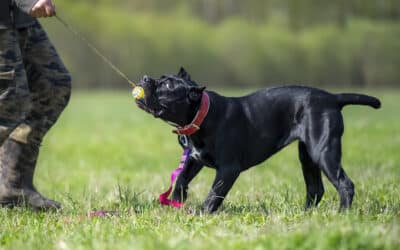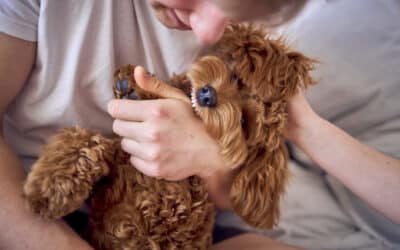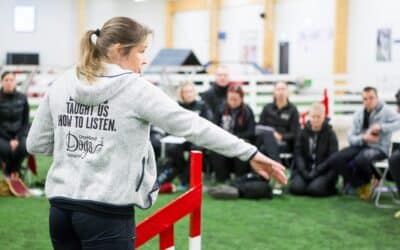In our 3 Reasons to Try Dog Agility webinar, I mentioned that there are two types of dogs: thinkers and doers. When it comes to dog training, if we think of them as two learning styles, we can use them to personalize training sessions for the highest success rate. Dogs learn in different ways, so a tailored approach is the best way to hold their interest.
Here are some tips on each learning style and how they can make your dog training sessions more successful.
Dog training for doers and thinkers — what’s the difference?
We can split doers and thinkers by how they like to problem solve. Doers are all action, they prioritize moving around and trying different things in a session. They don’t mind lots of repetition, so long as they don’t get bored.
Thinkers like to sit back and analyze first. They do best with tasks that can be broken into smaller pieces so they can move on quickly. While thinkers are very methodical dogs, they want to get things right the first time. From their perspective, repetitions signal that there’s something wrong, which can be frustrating or confusing.
For all their differences, one style isn’t better than the other. Instead, they highlight what your dog prioritizes, which will help you build their confidence with each training session. So what can you do to help your specific dog? Let’s start with the best practices for training each style of learner.
Dog training tips for doers
Doers appreciate exercises that involve a lot of motion. They’re quick starters, so adding movement earlier will keep sessions from feeling too stagnant. Doers may jump in at full speed, but they rarely connect the expectation of the exercise right away.
Action-oriented dogs become more thoughtful over time as they get more confident thinking through problems. Because of their eagerness, they need more help regulating how often they repeat an exercise. For a doing dog, every repetition is an opportunity to try new things.
Their focus will improve as they learn to think through problems, so the key is to keep them mentally stimulated as they move through a session.
Dog training tips for thinkers
While doers are constantly moving, thinkers tend to start slowly and speed up as the session goes. That’s why they appreciate smaller tasks that can complete quickly and get right the first time. Breaking down longer exercises helps them build momentum and approach the next task with more confidence.
When training a thinker, try to keep sessions short by moving quickly between tasks. Thinking dogs try very hard to be correct – they like getting things right the first time. Doing fewer repetitions will keep them mentally stimulated and encourage them to trust their problem-solving skills as they progress.
Personalized dog training is the key to success
Dogs, like people, learn in different ways that come more naturally to them. As trainers, our job is to find the approach that helps them thrive, which means thinking about each session from your dog’s perspective.
Both learning styles have their merits and drawbacks. Personalized training makes the most of their strengths while overcoming challenges. Best of all, doers and thinkers will learn from each other as they grow and progress.
With time, doers learn to analyze, focus, and think through problems, helping them succeed with fewer repetitions. With thinkers, the goal is to give them the confidence to explore and try new things. Even then, successful sessions are based on your dog’s natural behavior.
Tasks that are too small can frustrate a doer in the same way repetition makes a thinker shut down. Knowing your dog and learning how to work as a team is the perfect foundation for agility training.
Get the best online training for your dog
Now that you’re thinking about what type of dog you have, consider your learning style. Are you a thinker or a doer? Do you like to explore a problem as you go or do you start by coming up with possible solutions? How do you prefer being taught?
The better we understand our dogs, the easier it is to set realistic expectations, build a connection, and make each session fun. A vital part of agility is knowing how to train the dog in front of you. To get more tips on how to train your dog you can follow our foundation for agility program, click the button below to get started.
— Katelyn Scott, OneMind Dogs coach



